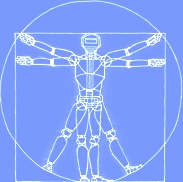
GroEL - A Protein Folding Machine
Art Horwich, Yale UniversityA host of cellular systems employ molecular machines to carry out specific work, comprising nano-scaled robotics systems. We have been studying one such machine, called a chaperonin, that has the remarkable ability to mediate protein folding in the cell, the final step of information transfer from DNA to effector protein. We have been studying the bacterial chaperonin, GroEL, a double ring machine, whose minimal functional unit, a ring, is comprised of 7 identically-behaving subunits. A ring operates in successive states whose forward progress is directed, as in many other molecular machines, by the binding and hydrolysis of ATP: an open ring, with a hydrophobic lining, captures a non-folded protein via its exposure of hydrophobic surfaces, and then, after binding 7 ATP and a lid-like cochaperonin called GroES, functions as an encapsulated closed now-hydrophilic folding chamber that mediates productive protein folding. The timing of this folding step, the longest step of the reaction cycle, is governed by ATP hydrolysis, whose occurrence discharges the folding-active ring. The "working parts" of the chaperonin rings are its subunits, each composed of two major domains, a so-called apical domain able to bind polypeptide via exposed hydrophobic surface, and an equatorial domain, able to bind and hydrolyze ATP. These two domains are attached to each other through a smaller intermediate domain, hinged at both its top and bottom aspect to allow rigid body movements of the apical domains on what is a stable collective of 7 equatorial domains that form the "base" of the machine. Nature has thus employed this simple subunit architecture, fundamentally enabling ATP-driven rigid body movement, 60° elevation and 90° twist of the apical domains relative to the equatorial domains, to assure that proteins can properly fold.
Biography
Arthur Horwich trained in pediatric medicine but became interested in the power of genetics and biochemistry to inform about biological systems. He studied a lethal inherited human disease affecting a mitochondrial enzyme and this led him to study its biogenesis, involving transport of the newly-synthesized enzyme subunit across the mitochondrial membranes. During such studies in a yeast system, his group stumbled across a specialized protein, a large double ring "machine" called a chaperonin, found to be required for proper folding of proteins. Chaperonins turn out to be present ubiquitously, mediating the folding of a large number of newly-synthesized proteins in all three kingdoms of life. Using a series of studies including biochemical reconstitution, electron microscopy, and X-ray crystallography, it has been possible to deduce a reaction cycle of the bacterial chaperonin machine, GroEL, in which steps of ATP binding and hydrolysis provide the energy to drive large movements in the machine between states that effect distinct steps of capturing non-native polypeptide in an open ring, productively folding it to its native state inside the machine, and then releasing it.
